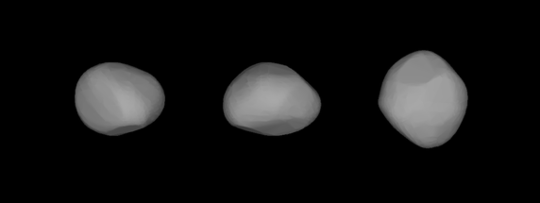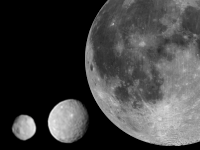Assuming you mean a liquid ocean of water which beings sufficiently adapted could potentially swim all the way through, it would have to be small because water when compressed enough becomes ice - or else - to have a hot core, which it might have soon after formation, or be tidally heated.
So, first, the easiest case, if you don’t need it to have enough gravity to hold an atmosphere, I don’t see why not. Basically you want a large comet, in an orbit which keeps it permanently liquid. We could create such a world artificially in our solar system with mega engineering by diverting a comet into just the right orbit around the Sun.
However, unless we add something extra to the picture, it wouldn’t last long. The problem is that water evaporates rapidly in a vacuum. And to have enough gravity to stop that happening
With surface temperature of 273.15 K and using the equation for mass loss of liquid water in a vacuum of
$\text{(pe/7.2)} \times\sqrt(M/T) kg / m2 / sec$
(equation 3.26 - compare calculation results here: Modern Vacuum Physics)
where M is the molar mass, T is the temperature in kelvin, pe is the vapour pressure, which for water at 0 C (273.15 K) is 611.3Pa, (Vapour pressure of water at 0 C), M = 0.018 kg, gives
$$\text{(611.3/7.2)} \times \sqrt(0.018/295) = \text{0.663 kg / m2 / sec}$$.
So you lose about 57 meters a day thickness of liquid water exposed to a vacuum, or about 20.9 kilometers of water per year. The rate of loss goes up if the temperature increases and is 2.495 kg / m2 /sec at 295 k, or 22 C. That’s 215.6 meters per day and 78.6 km per year.
So, a liquid water comet would not last for long. That is unless you get a constant influx of other comets bringing more water to it.
What if the object is large enough to retain liquid water for long periods of time?That’s only possible if it has at least enough gravity to retain a significant amount of atmosphere, even if the atmosphere is just water vapour, or oxygen (after dissociation of the water by radiation).
~But then - it will surely have a solid ice core. In that case, if the water is also salty, it might well have a “club sandwich” type pattern of alternating layers of ice and water as suggested for Ganymede, of various types of ice, with some of them “snowing upwards”
[ ]
]
Ganymede׳s internal structure including thermodynamics of magnesium sulfate oceans in contact with ice
But even Ganymede is not large enough to retain an atmosphere to protect the surface layer of water. Its diameter is 5,268 km so if brought close enough to the Sun to have a permanently liquid surface layer, it would vanish completely in 67 years.
It could build up a temporary atmosphere though as the water evaporated. It’s gravity is similar to the Moon’s.
Can we terraform the Moon? If yes, how difficult is it and is it possible with the current technology?
So using a calculation from that answer, if you hit it with a comet 164 km in diameter you’d have enough material for an atmosphere which would last for 10,000 years. Since the volume goes up as the cube, that means with a similar pressure atmosphere, a moon the size of Ganymede could last for $\text{10,000}\times\text{(5,268/164)}^{3}$ = 331 million years before evaporating completely if it built up an Earth pressure atmosphere. And the atmosphere would consist of water vapour and oxygen, so might well be breathable too, especially if you can somehow introduce some nitrogen as a buffer gas.
But that’s still no good if you want the core to be liquid all the way through.
There is another solution though. If you are willing to do it artificially, you could cover the entire surface of a small comet with a low density liquid which also has a low evaporation pressure.
Indeed, comets are rich in organics anyway, so if you could bring a comet to just the right distance from the Sun, not too far, not too close, then as it melted, it would develop a layer of scum like that. And that might well be habitable too, with organics and an oxygen rich ocean too, due to similar processes to the ones that make Europa’s ocean oxygen rich.
Organics with a high evaporation rate would disappear leaving only those with a low evaporation rate, and perhaps solid layers as well.
So if you are okay with your planet being a tiny comet sized object, and your water can be a bit “dirty” with organics, which means it can also support life, I’d say yes, it does seem possible.
Europa’s ocean may be as much as 100 km thick, with a surface layer 10 - 30 km thick.
 Based on that, you could have a minor planet made of ice, 260 km in diameter, and consisting entirely of water, I think, with a surface layer of organic ionic fluids or a scum of organics in solid form floating on the surface. That could last for billions of years.
Based on that, you could have a minor planet made of ice, 260 km in diameter, and consisting entirely of water, I think, with a surface layer of organic ionic fluids or a scum of organics in solid form floating on the surface. That could last for billions of years.
That makes it about the same size as 88 Thisbe

Vesta’s double that diameter

Vesta, Ceres and the Moon to scale at 20 km per px
I’m just using the figures for Europa and the depth of its subsurface ocean, which is kept liquid by tidal heating, and assuming the situation is similar - so this is just a rough estimate as it would depend on what you have by way of an energy source to keep your planet or moon warm. With just surface heating, surely the center would cool down eventually.
Tidal heating could be a way to keep your planet liquid just as for Europa, so if you make it so that it orbits a hot Jupiter - those are planets like Jupiter that end up in orbits close to their sun, and they may well have liquid water moons.
Another solution, without the layer of ionic liquids or similar, is to have a constant influx of comets to replenish the water. I can imagine some scenarios where that could work, e.g. soon after formation of a solar system. It also might work for a while later on in a white dwarf star with material brought into it through destruction of its Oort cloud and perturbing effects of an extra planet, see Our Solar System Could Lose One Or More Of Its Gas Giants Billions Of Years In The Future - and that would also help keep it hot. In a situation like that maybe even quite a large minor planet would stay hot enough to stay liquid all the way through. But the tidal heating + surface thin layer seems the easiest solution to me.
So, in short, I think this scenario could actually exist in nature, if you don’t mind having an ocean rich in organics, covered with a thin layer of organics, and make it a moon orbiting a gas giant rather than a planet on its own.
This is just a rough estimate. Would be interesting if someone was to do a paper on it - has anyone? Would a liquid water world the size of Vesta or even Ceres be possible, with tidal heating to keep it warm? Can a hot Jupiter have a moon of pure ice? (I don’t see why not if it formed far enough away from its host star originally, but would be interesting to know how likely that is).
This is a copy of my quora answer to Is a planet entirely made of only liquid possible?
 ]
]


29Liquid water all the way down? Or is a water ice core ok? – Samuel – 2014-12-04T20:33:14.780
8
I believe the Star Trek episode you have in mind is VOY 5x09 Thirty Days, where Voyager encounters a ball of water held together by a containment field generated by an ancient field generator, which in turn was built by an earlier civilization which disappeared before the people who live there when Voyager encounters them arrive. Do note that this does not fit your criteria; it is not held together by its own gravity (in fact generator failure is a major plot device), and it is debatable whether it is made up completely of water.
– a CVn – 2014-12-04T20:41:25.2632@Samuel: A water ice core would be OK (I guess only liquid water would be impossible due to the huge pressure). – celtschk – 2014-12-04T20:41:39.507
@MichaelKjörling: Yes, I think that's the episode I remembered, thank you. I'll edit that info in. And you're right, it doesn't fit my criteria. – celtschk – 2014-12-04T20:48:38.187
Abyss Deep by Ian Douglas has a world that is mostly water, I think there might be a small core at the center, but it has a lot of exotic ice around the core. – bowlturner – 2014-12-04T20:49:17.480
8The water on Naboo goes all the way down through the core, doesn't it? If it's in Star Wars, it must be possible! – KSmarts – 2014-12-04T20:55:47.033
Water ice floats, so I don't think that would make up the core if liquid water was present. I think the question is does water break down under the levels of pressure found at the core of a planet which would cause it to form other elements or compounds? – GrandmasterB – 2014-12-04T20:56:06.350
13@GrandmasterB actually that is only normal ice, I think there are 10+ different types of ice, most are not possible here on earth, some of them would be created at great pressures such as being in the center of a planet size mass of water. They are called Ice because they are forms of solid water. – bowlturner – 2014-12-04T20:57:50.300
@bowlturner oh, that's neat. I never knew that. – GrandmasterB – 2014-12-04T21:07:10.097
18@bowlturner You really have to be careful with the ice-nine. – KSmarts – 2014-12-04T21:13:54.717
3@KSmarts as opposed to ice IX? yes. – bowlturner – 2014-12-04T21:17:39.937
3Note that the ball of water in Voyager is not the size of a planet. It's got a 600km radius (Earth's moon has ~1700km equatorial radius); the closest to that in our solar system is Charon (~603km radius, Pluto's largest satellite). – Brian S – 2014-12-04T21:40:17.380
@BrianS: Good point; I wasn't aware of that fact. – celtschk – 2014-12-04T21:50:03.623
1
@bowlturner, Well, deuterium (heavy hydrogen) -- which apparently powers just about every space ship in Star Trek -- with oxygen can freeze to become "heavy ice", which will sink in water. If I recall some napkin math I performed a while back, something in the neighborhood of 50kg of Earth's ocean water (at STP) contains 1g of heavy water, which if you can extract will freeze just fine. A quick glance around the web indicates you can buy heavy water for around US$1000/L
– Brian S – 2014-12-04T22:02:59.757@BrianS Very interesting, (ok most of the ice doesn't occur naturally here one earth...) :) – bowlturner – 2014-12-04T23:01:15.707
I just love this question cause I watched that Voyager episode not long ago. – The Mattbat999 – 2018-12-02T14:45:33.933
1
Discussed here: http://worldbuilding.stackexchange.com/questions/9922/must-all-planets-have-a-solid-liquid-core My answer is yes, conditionally: must be small, must be hot, must be clean, and must be kept that way
– user3082 – 2015-09-23T00:40:09.323